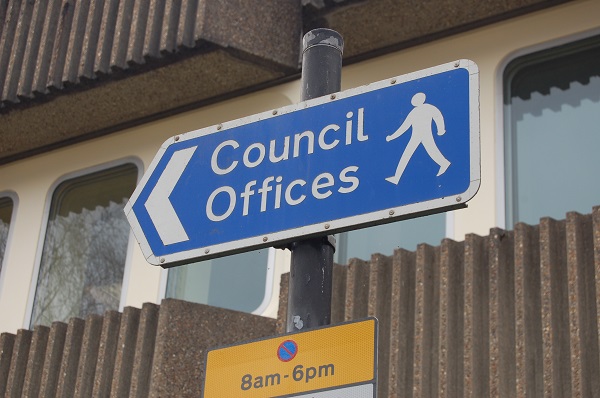Local government
(Created page with "File:Council-Office-Sign-600.jpg Local government is a type of public administration that is responsible for a range of services in certain defined areas. Although it varies...") |
|||
| Line 1: | Line 1: | ||
| − | [[File:Council-Office-Sign-600.jpg]] | + | [[File:Council-Office-Sign-600.jpg|link=File:Council-Office-Sign-600.jpg]] |
| − | Local government is a | + | Local government is a form of public administration responsible for a range of services and other functions within defined local areas. Although it varies country-by-country, local government is generally the lowest administrative tier and contrasts with the national government or regional government. |
| − | + | The services and functions that fall under the remit of local government in the UK include; schools, housing, planning permission, building control, town planning, social care, waste collection, licensing, and so on. | |
In 1974, a two-tier administrative structure was established for local government in England and Wales with functions allocated at the level at which they could be practised most efficiently. | In 1974, a two-tier administrative structure was established for local government in England and Wales with functions allocated at the level at which they could be practised most efficiently. | ||
| Line 36: | Line 36: | ||
* Unitary authority. | * Unitary authority. | ||
| − | [[Category:Organisations]] [[Category:Planning_permission]] [[Category:Policy]] [[Category:Taxation]] [[Category:Roles_/_services]] | + | [[Category:Organisations]] [[Category:DCN_Organisation]] [[Category:Planning_permission]] [[Category:Policy]] [[Category:DCN_Policy]] [[Category:Taxation]] [[Category:Roles_/_services]] |
Revision as of 15:19, 1 November 2018
Local government is a form of public administration responsible for a range of services and other functions within defined local areas. Although it varies country-by-country, local government is generally the lowest administrative tier and contrasts with the national government or regional government.
The services and functions that fall under the remit of local government in the UK include; schools, housing, planning permission, building control, town planning, social care, waste collection, licensing, and so on.
In 1974, a two-tier administrative structure was established for local government in England and Wales with functions allocated at the level at which they could be practised most efficiently.
The two tiers are:
- County councils, responsible for services across an entire county, such as; education, transport, planning policy, fire, public safety, social care, libraries, waste management, trading standards, and so on.
- District, borough or city councils, covering a smaller area and responsible for local services such as; rubbish collection and recycling, council tax collections, housing and planning applications.
The local government reorganisation in the 1990s, introduced unitary authorities - single-tier administrations with responsibility for all aspects of local government in their area.
The power to create combined authorities was introduced in the Local Democracy, Economic Development and Construction Act 2009. Combined authorities are legal structures that can be created by two or more local authorities in England to undertake joint functions and take collective decisions across council boundaries.
Local government bodies are funded through a range of sources, including government grants, fees and charges, as well as through the paying of council tax by the residents within the relevant boundaries.
The Local Government Association (LGA) is an organisation which comprises local authorities in England and Wales and seeks to lobby in their favour and represent their interests to national government.
The central government department responsible for local government is the Ministry of Housing, Communities and Local Government (MHCLG).
Related articles on Designing Buildings Wiki
- Combined authorities.
- Delegated powers.
- Local authority.
- Local planning authority.
- Localism Act.
- Planning authority.
- Public authority.
- Metropolitan counties.
- Town council.
- Town planning.
- Unitary authority.
Featured articles and news
Infrastructure that connect the physical and digital domains.
Harnessing robotics and AI in challenging environments
The key to nuclear decommissioning and fusion engineering.
BSRIA announces Lisa Ashworth as new CEO
Tasked with furthering BSRIA’s impressive growth ambitions.
Public buildings get half a million energy efficiency boost
£557 million to switch to cleaner heating and save on energy.
CIOB launches pre-election manifesto
Outlining potential future policies for the next government.
Grenfell Tower Inquiry announcement
Phase 2 hearings come to a close and the final report due in September.
Progress from Parts L, F and O: A whitepaper, one year on.
A replicated study to understand the opinion of practitioners.
ECA announces new president 2024
Electrical engineer and business leader Stuart Smith.
A distinct type of countryside that should be celebrated.
Should Part O be extended to existing buildings?
EAC brands heatwave adaptation a missed opportunity.
Definition of Statutory in workplace and facilities management
Established by IWFM, BESA, CIBSE and BSRIA.
Tackling the transition from traditional heating systems
59% lack the necessary information and confidence to switch.
The general election and the construction industry
As PM, Rishi Sunak announces July 4 date for an election.
Eco apprenticeships continue help grow green workforce
A year after being recognised at the King's coronation.
Permitted development rights for agricultural buildings
The changes coming into effect as of May 21, 2024.






















